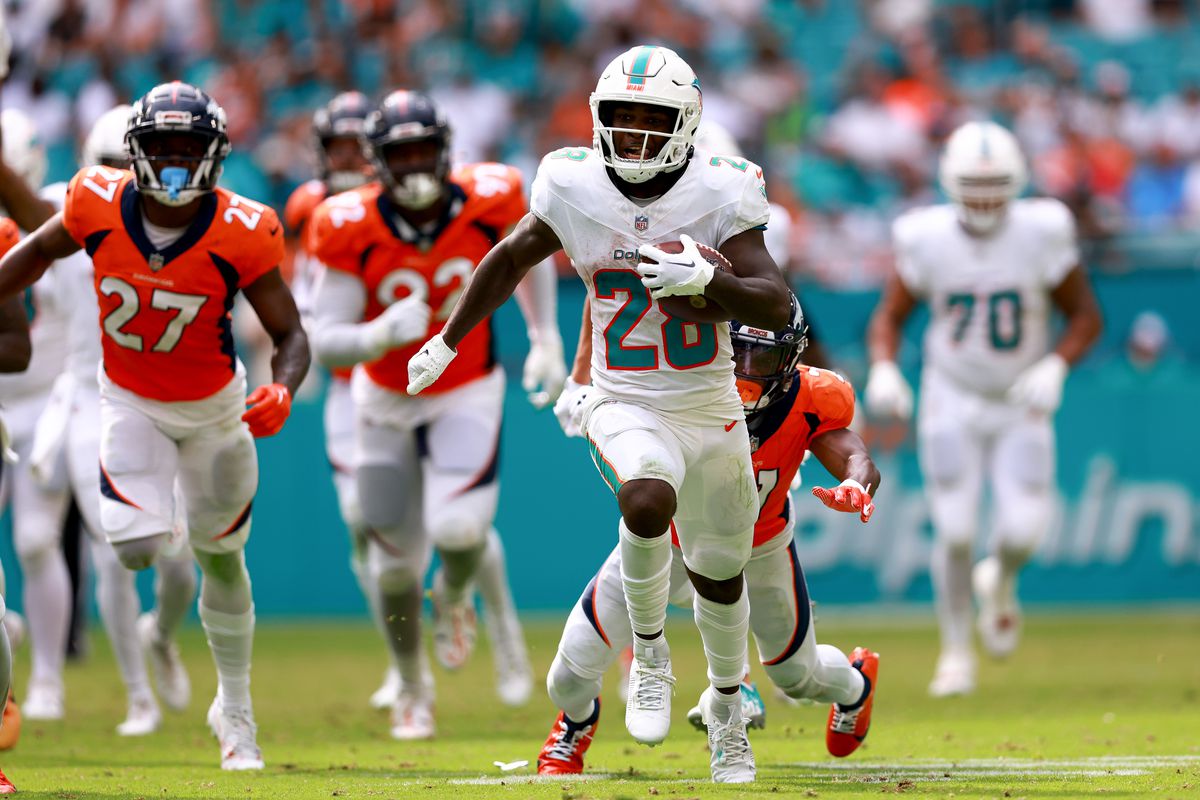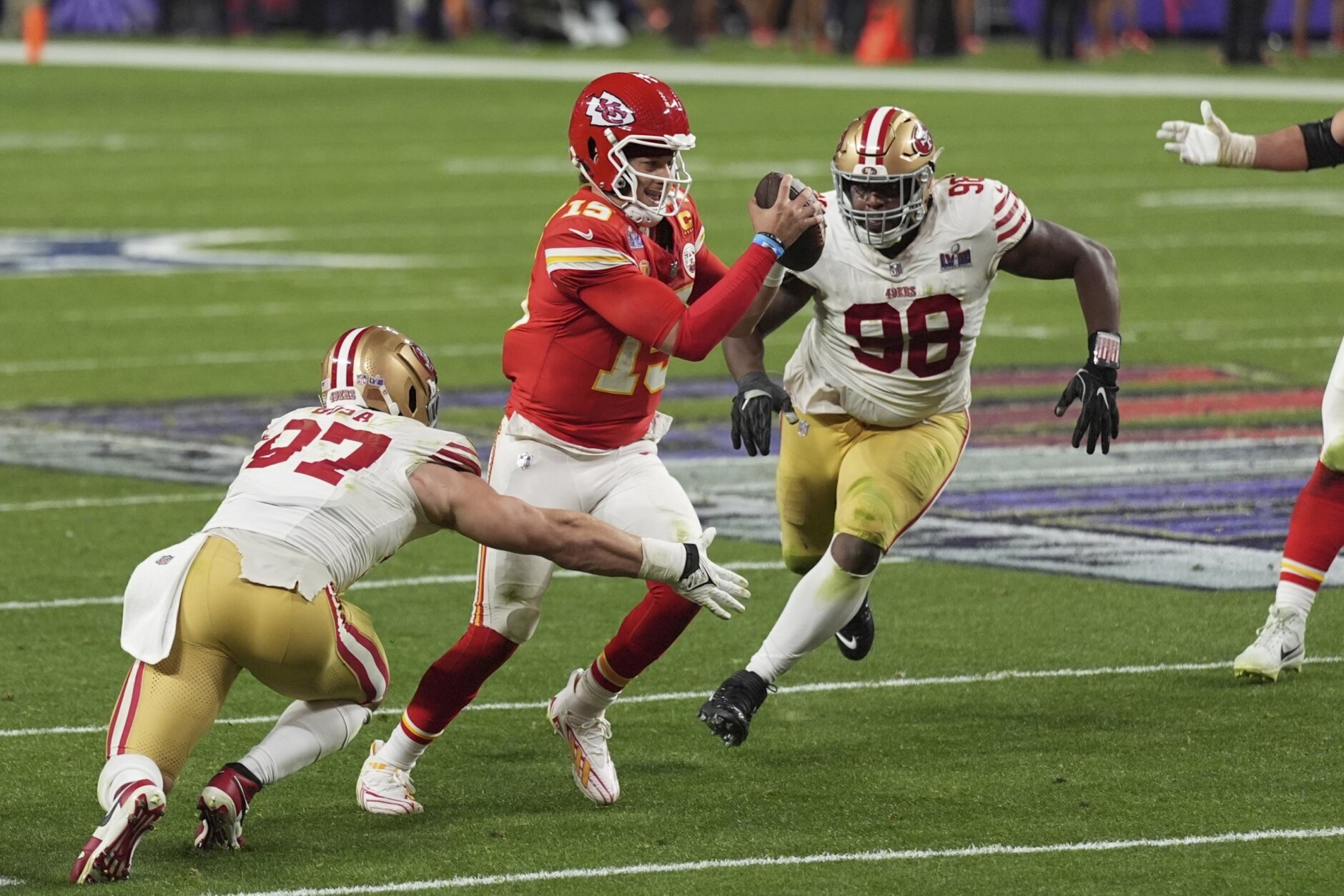Introducing Threat Ratings, by Field Vision
-min.jpg-c4KKftxLYFjk5RLbguaFeNzbEl7fh1.jpeg&w=3840&q=75)
Setting a New Standard for Evaluating Offensive Player Production
‘threat’: a person or thing likely to cause damage or danger.
By now you should know we like definitions here at Field Vision. Why? We’re looking for the simplest way to describe to fans what’s happening on a football field. Over the last three weeks we introduced Havoc Ratings to the world as our proprietary way to measure the quality of defensive players across the NFL. You can learn more about Havoc Ratings, and our positional rankings HERE.
But what about offense? And evaluating offensive players? Well – it’s not an offensive players’ job to create ‘havoc.' Creating Havoc is about disrupting a well-laid plan. Offensive players are trying to execute a plan so ruthlessly, so efficiently that the damage or “danger” they present to a defense almost feels inevitable. Again, let's think Miami Dolphins against the Denver Broncos last September.

So with this idea in mind, we at Field Vision present to the world our offensive Threat Ratings - a comprehensive, data-based, outcome-driven method for evaluating offensive players. From here on out, when we talk about offensive players we’ll refer to their Threat Rating as a way to rank them in relation to their peers.
How is Threat Rating Calculated?
We made Threat Ratings the exact same way we did our Havoc Ratings - by creating a model that calculates Individual player impact on a play-by-play basis, accounting for virtually every outcome a player is responsible for that creates (or degrades) value for their team. We did this by training a model to learn the value of individual player contributions (both positive and negative) based on years of NFL offensive play-by-play data. These contributions include everything we could measure. On the offensive side of the ball, here are some things our model learned:
Avoiding a Turnover is still the most valuable offensive play in football (saving your team over a field goal in expected points). Yes, we want our QBs to take shots and ball-carriers to break tackles, but turning the ball over is the equivalent of giving the other team a field goal.
Explosive plays (a run or a pass) are worth nearly a FIELD GOAL a piece, by themselves. It’s valuable to take shots…just don’t turn the ball over☺️
Passes are between 2-3x for valuable than runs, on average, because of the increased probability of a passing play turning into an explosive.
A receiver who can consistently create separation, turn receptions into YAC and make contested catches (i.e. turning a negative play into a positive one) is the most valuable, non-QB position in football.
One single pressure avoided by a Quarterback is worth OVER 1-point of expected value to his team.
With this model, we have been able to measure every offensive player's impact on every snap, in every game over the last 5 NFL seasons. We then aggregated this data over games, over seasons, and (accounting for injuries and time) have projected their scores forward into 2024 to determine who are the most valuable offensive players at their given positions across the NFL.
Why are our Threat Ratings better than Traditional Offensive Metrics?
You might be wondering why you need another offensive metric when we already have so many? It’s a fair question. The simple answer is, because threat rating is better. It’s a far more comprehensive method of evaluating performance when compared to metrics such as yards, catches, completion %, ADOT, success rate, or even expected points added (EPA).
But because we know you’re going to check our math (and we want you to), the slightly more nerdy answer comes down to three things:
Threat Rating is a comprehensive measure of Value: Who was the best receiver in the league last year? Yards or TDs would tell you it was Tyreek Hill. Targets, Receptions or EPA would tell you Ceedee Lamb. ADOT would tell you it was Mike Evans. Contested Catch Rate...Brandon Aiyuk. YAC? Amon-Ra St. Brown. We have no comprehensive measure that accounts for EVERYTHING a receiver does on the field, while taking into account the relative value of all of these things to give us a comprehensive measure of value. Until now. This is what Threat Rating does.
Attributing value where it’s deserved: Football is the ultimate team sport, which is why we love it. At times, it can be difficult to determine whether or not a player is truly elite, or just surrounded by elite teammates. The debate over Brock Purdy comes to mind. With our Threat Ratings, we are able separate out a QB from his pass catchers, and attribute value to either a QB or a receiver based on the play-by-play dynamics that are taking place on the field.
Accounting for Hidden Value. How do you account for ‘hidden value’ in the game? The value that can’t be measured. A QB avoiding a sack, just to throw the ball at a receivers feet to save 10 yards. A WR that turned a turnover-worthy throw into a 20-yard reception. Threat Rating accounts for all of this in a way that traditional metrics cannot.
So How Will We See Threat Rating being Used?
Field Vision's Threat Rating, similar to Havoc, is an expression of a players value (i.e. How good they are) relative to others in their position group. Our goal is to get to the most precise, data-informed ranking of players and how good they are based on the play-by-play results they actually produce on the field.
We express this rating in the form of a percentile from 0-100, weighted within each position group. What does that mean? We are comparing the Threat that WRs create relative to other WRs, TEs to other TEs, Running backs to other Running backs and Quarterbacks to other Quarterbacks.
There is one other REALLY important thing: Because we’re building our Threat Ratings up play-by-play, we can also understand situational performance. When we roll out our QB Threat Ratings, you’ll see the most comprehensive way to evaluate Quarterback performance that you’ve ever seen. Patrick Mahomes is the best QB in the league against Zone defense, while Josh Allen is the best against Man coverage. Lamar Jackson is the most valuable QB when running the football (not surprising), but Mahomes is again #1 when you just account for non-designed QB scrambles. Jared Goff is the best QB when throwing the ball short (0-10 yards), with CJ Stround the best at throwing deep. Tua is the #1 QB when it comes to running play-action. You get the idea. The insights run deep.

So What's Next?
From here on out, you’re going to hear about Threat Ratings a lot from Field Vision. It’s our unique, proprietary, football outcome + data-driven point of view on who’s good, and who’s not. In our (completely unbiased) opinion, just like Havoc Ratings, our Threat ratings will set the standard for how we truly evaluate offensive player performance based on the outcomes they have actually produced, and the math behind what truly matters to winning.
This week, we’ll release our Wide Receiver and Tight-End Ratings, followed by running backs next week and QBs the week to follow.
As we continue to roll-out our Threat Ratings to the world, we look forward to the conversation, debate and your feedback as always. Hit us at @fieldvisionmi on X, @fieldvisionsports on Instagram, or on our website www.fieldvisionsports.com.
Here's the good news: Only 30 days til football season…
-min.jpg-c4KKftxLYFjk5RLbguaFeNzbEl7fh1.jpeg)